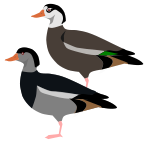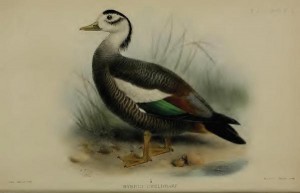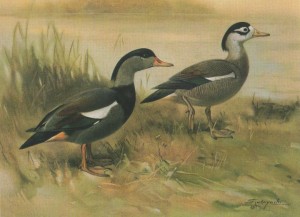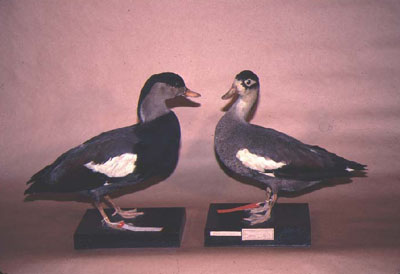November 25, 2010
Korean Crested Shelduck: A Cryptid Bird

Korean crested shelduck. Tadorna cristata. Distinctive head, green on top and gray below in the male, and black on top and whitish below in the female. Green lower neck and upper chest, the rest dark gray. First recorded in 1877 near Vladivostok, Siberia, but not accepted as a distinct species until 1917 after a female was taken near Pusan, South Korea. Now critically endangered and possibly extinct. Recently reported in a variety of inland wetlands in China. Elsewhere, the most recent unconfirmed sightings are on an island southwest of Vladivostok in 1964; on the northeast coast of North Korea in March 1971; and in eastern Russia in March 1985.

The Crested Shelduck or Korean Crested Shelduck, Tadorna cristata, is a species of bird in the family Anatidae. It is critically endangered and believed by some to be extinct. The male Crested Shelduck has a greenish-black crown, breast, primaries, and tail, while the rest of its face, chin, and throat are brownish black. The male’s belly, undertail coverts, and flanks are a dark grey with black striations. The upper wing coverts are white, while its speculum is an iridescent green. The female has a white eye ring, black crest, white face, chin, throat, neck, and uppers wing coverts and a dark brown body with white striations. Both sexes also have a distinctive green tuft of feathers protruding from the head.
Very little is known about this bird because of the limited number of observations of this species. It apparently bred in Korea and eastern Russia and was probably a relict species that had a wider distribution in prehistoric times. Some think that this species is extinct, although occasional sightings are reported, including a number of recent reports from the interior wetlands of China. Due to the persistent reports of the species’ survival, it is listed as critically endangered. However, it has not been definitively sighted since 1964.

The Crested Shelduck was initially reported in 1890 as a possible hybrid between the Ruddy Shelduck (Tadorna ferruginea) and Falcated Duck (Anas falcata) by English zoologist William Lutley Sclater. Around 1913, a pair was collected in Korea, and presented to Japanese ornithologist Nagamichi Kuroda. Another female was collected in 1916, and with three specimens of a bird which was clearly not a hybrid, Kuroda described this bird as Pseudotadorna cristata in 1917. The second female was designated the holotype and preserved with the male in Kuroda’s collection. A member of the family Anatidae, this species was considered distinct enough to merit its own genus by Kuroda, and is now placed in the genus Tadorna, which includes six other species of Old World shelducks. The genus name Tadorna comes from the Celtic word tadorne and means “pied waterfowl”, essentially the same as the English “shelduck”. The specific epithet, cristata, comes from the Latin word for crested. The species’ common name is derived from the tuft of green feathers from the shelduck’s head. This species is also known as the Korean Crested Shelduck, Korean Sheldrake, and Korean Mandarin.

Male (left) and female specimens, Kuroda collection, Tokyo, Japan
The Crested Shelduck is sexually dimorphic, with the male having a greenish-black crown, breast, primaries, and tail, while the rest of its face, chin, and throat are brownish black. The male’s belly, undertail coverts, and flanks are a dark grey with black striations. The upper wing coverlets are white, while its speculum is an iridescent green. The female has a white eye ring, black crest, white face, chin, throat, neck, and upper wing coverts. It also has a dark brown body with white striations. Both sexes have a green tuft of feathers protruding from their head. The Crested Shelduck is about 63 to 71 centimetres (25 to 28 in) long and slightly larger than a Mallard. Its wingspan is about 31 to 32 centimetres (12 to 13 in). Its bill and legs are pinkish, though those of the female are paler than those of the male. The plumage of the immature is unknown.
Sea of Japan, where most reports of the Crested Shelduck come from
The Crested Shelduck has been collected near Vladivostok in Russia and near Fusan and Kunsan in Korea. It has been proposed that the species breeds in far-eastern Russia, northern North Korea, and northeast China and winters in southern Japan, southwest Korea, and along the east China coast as far south as Shanghai. It is believed to have a relict range, or to have been more widespread in historic times.
This species is believed to live in a wide variety of wetland and deep-water habitats at varying elevations. While all collected individuals are from the coast, especially near river mouths, recently there have been a number of reports from interior wetlands in northeastern China. It has been speculated that this species may breed in mountainous areas either away from water or on volcanic lakes.
Though not much is known about this shelduck, it is believed to be migratory, traveling from Siberia in the breeding season to Korea, southern Russia, and Japan for the winter. The Crested Shelduck is believed to eat aquatic vegetation, agricultural crops, algae, invertebrates, mollusks, crustaceans, carrion, and garbage. It has been suggested that this shelduck may be a nocturnal feeder. While its nest has not been described, similar shelducks nest in burrows and cavities and it has also been suggested that this species may nest in tree cavities. The bird is also suggested to lay less than ten eggs which the female alone incubates. It is believed to breed from May to July. The shelduck has been observed in flocks of two to eight birds.
The Crested Shelduck was never numerous in modern times, though it is thought to have been more widespread historically. The species is known from only a handful of sightings and some declared it extinct in 1916 after a female was shot at Busan, South Korea. In 1943, a sighting of this bird was reported near Chushinhokudo, building hopes that the species persisted. A group of three birds was sighted in 1964 in the Rimsky-Korsakov Archipelago near Vladivostok with a small flock of Harlequin Ducks. In 1971 it was reported from North Korea’s northeast coast and in 1985 two were reported from eastern Russia. However, there are severe doubts about the accuracy of the 1971 record. A recent survey of Chinese hunters resulted in a number of unconfirmed reports from northeastern China. There are also unconfirmed reports of about twenty Crested Shelducks in the Dashanbao region of Yunnan, though many believe this flock to be a misidentified flock of Ruddy Shelducks. It is believed that, if the species survives, there likely are fewer than 50 individuals.
This species is threatened with extinction due to habitat loss, hunting, and overcollecting. Recently, a Chinese forest worker claimed that he unknowingly ate two in 1984. In an attempt to gather reports of this species and raise awareness so that they are not eaten, 300,000 leaflets were distributed in Russia, Japan, China, South Korea, and North Korea in 1983, with the only resulting report being the 1971 North Korea record. 15,000 leaflets were distributed in northeastern China in 1985 and 1991. While this garnered 82 reports of the species, follow-up surveys of the area failed to find the shelduck.
This duck was collected and exported to Japan between 1716 and 1736 for aviculture, where it was known as the Korean Mandarin Duck. It was captured for aviculture in Japan up to at least 1854 and was portrayed in the Kanbun-Kinpu, a Japanese avicultural work. Old Chinese tapestries also portray a duck similar in appearance to the Crested Shelduck. Three specimens exist in museums. The only male specimen is kept with a female in the Kuroda collection at Tokyo. The male was collected at the mouth of the Geum River in 1913 or 1914, and the female was collected near Busan in December 1916. The female specimen described by William Lutley Sclater, collected by Lieutenant F. Irmininger near Vladivostok in April 1877, exists in the National Museum of Denmark in Copenhagen. In 1991, the Crested Shelduck appeared on a Mongolian postage stamp.
 About Loren Coleman
About Loren Coleman
Loren Coleman is one of the world’s leading cryptozoologists, some say “the” leading living cryptozoologist. Certainly, he is acknowledged as the current living American researcher and writer who has most popularized cryptozoology in the late 20th and early 21st centuries.
Starting his fieldwork and investigations in 1960, after traveling and trekking extensively in pursuit of cryptozoological mysteries, Coleman began writing to share his experiences in 1969. An honorary member of Ivan T. Sanderson’s Society for the Investigation of the Unexplained in the 1970s, Coleman has been bestowed with similar honorary memberships of the North Idaho College Cryptozoology Club in 1983, and in subsequent years, that of the British Columbia Scientific Cryptozoology Club, CryptoSafari International, and other international organizations. He was also a Life Member and Benefactor of the International Society of Cryptozoology (now-defunct).
Loren Coleman’s daily blog, as a member of the Cryptomundo Team, served as an ongoing avenue of communication for the ever-growing body of cryptozoo news from 2005 through 2013. He returned as an infrequent contributor beginning Halloween week of 2015.
Coleman is the founder in 2003, and current director of the International Cryptozoology Museum in Portland, Maine.
Email • Facebook • Twitter •
Filed under Avian Mysteries, CryptoZoo News, New Species




